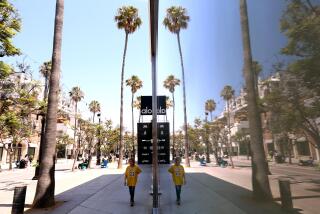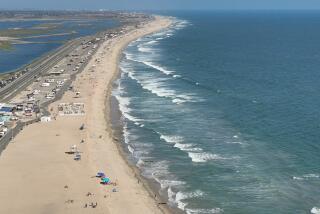Pavilion Finally Has Fans : Venice: Activists push for new uses for beach structure that was envisioned as a community center. Others feel it should be destroyed.
In its troubled 28-year life, the Venice Pavilion has never had a heyday.
The senior citizens who were supposed to play shuffleboard and boccie ball behind its cement walls were frightened away by a nude beach that flourished--albeit briefly--nearby.
The theater companies that were supposed to fill its 800-seat auditorium found that the structure was too cold and cavernous.
The picnickers who were supposed to flock to the dozens of concrete tables and barbecue pits outside the building stayed away when the area began to attract drug dealers and the destitute.
But now that talk among some city officials has turned to the wrecking ball, a group of about two dozen Venice artists and activists has decided that the boarded-up community center on the sand just north of Muscle Beach deserves another chance.
Armed with about 4,500 signatures from residents and weekend strollers, the Coalition to Save Venice Pavilion is asking the city to open the doors that neglect forced shut nearly five years ago.
What they envision for the tan-colored building, however, is a future far grander than anything in its past.
In the cobwebbed and graffiti-covered auditorium, they imagine film festivals, crafts shows, jazz concerts and poetry readings.
On the nearly forgotten boccie courts, they see a rink for the hundreds of roller-skaters who zip past the pavilion each day. And past the dank and shadowy passageways where few dare to venture, they speak of a seaside cafe serving cappuccino.
“I really don’t think most people even know what’s in there,” said the group’s spokesman, Jerry Rubin, a longtime Venice peace activist (who is no relation to the 1960s-era radical leader). “If they did, they’d say, ‘My gosh. I can’t believe this has been left unused for so many years.’ ”
As part of its preservation effort, the coalition on Sunday tried to draw a couple hundred people from the crowd at the beach to form a “human circle of unity” around the dilapidated building.
But competing with the usual parade of daredevil roller-skaters, break dancers, masseuses, Tarot card readers and incense vendors proved more difficult than Rubin had expected.
In the end, just 22 people stood for a few minutes, their linked hands barely stretching across the building’s entrance.
“Oh well,” Rubin said. “This is still more people here than there have been in years.”
Undaunted, Rubin presses on.
The group this week is seeking city permission to hold a fund-raiser at the pavilion in December.
But officials in the city Recreation and Parks Department, which built the structure for about $1 million in 1961, are doubtful that life can--or should--be breathed into the ailing structure.
More than a year ago, the city and the California Coastal Conservancy launched a study of the entire Venice waterfront that included several public workshops on the fate of the pavilion.
Although one more meeting is planned for next month, officials in both agencies said it is clear from those who have attended that many consider the structure an incongruous eyesore that blocks their ocean view and robs them of their beachfront.
City and conservancy officials have stressed that they will respond to the wishes of the public in deciding the fate of the building. And if that means tearing it down, that is perfectly acceptable to them.
“Inherently, it is an inappropriate land use,” said Joel Breitbart, assistant general manager for planning and development in the Recreation and Parks Department. “I think the vast majority feel the community would be better served if it were sandy beach again.”
Dell Chumley, a longtime resident and past president of the Venice Town Council, also favors razing the facility.
“This is not some sacred burial ground that can’t be torn down,” said Chumley, who is a member of the SeaSkate committee, which wants to build a roller-skating platform in the community. “There are some really nice buildings in Venice that we should treasure, but the pavilion isn’t one of them.”
This is not the first effort to revive the facility, which sits behind a grassy area where Windward Avenue meets the boardwalk.
In the late 1960s, the Recreation and Parks Department built a roof over the original open-air amphitheater after theatergoers complained about the damp cold. Thespians, however, complained that the roof destroyed the acoustics.
In 1984, the city tried to solicit bids from private entrepreneurs to lease or buy the pavilion. But, despite offering as much as $1 million in matching city funds, there were no takers.
“The building was just an ill-conceived idea that ought to die,” said Los Angeles Police Sgt. J. P. Williams, who commands the Venice Beach substation in the pavilion’s basement. “It should just give way to the natural environment.”
Rubin, who also is director of the Los Angeles Alliance for Survival, a Venice-based peace organization, thinks there is already enough sand on the beach. But there is a dearth, he says, of public spaces for artists, actors, musicians and poets to share their talents with the community.
“It’s really a free-speech issue,” said Glenn Hopkins, a playwright who directed the last theatrical production at the pavilion in 1984 and supports the effort to save the structure. “More than 500,000 people pass by here every weekend day, and we have no way to draw on that crowd.”
More to Read
Sign up for Essential California
The most important California stories and recommendations in your inbox every morning.
You may occasionally receive promotional content from the Los Angeles Times.










